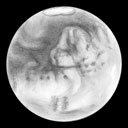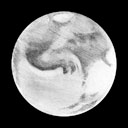Between August 28 and September 13, we produced one or more drawings of the planet on every night when the sky was clear, with the exception of one night when wildfires near the observatory were spewing ash into the air and did not allow us to open the dome. The first week we enjoyed burnished clear skies and the steady seeing which allowed us to study Mars for hours at a time! In order to eliminate chromatic aberration, we stopped the aperture to 20 inches. In order to avoid drawing what we knew rather than what we actually saw, we generally employed a diagonal prism to produce a mirror-image of the planet from the orientation usually presented: i.e., our view showed south at the top, but east and west were reversed from the usual inverted image. We hoped that this arrangement would encourage a "drawing with the right side of the brain" approach.
Most of the drawings were made with a Wratten 25 red filter to enhance contrast of the markings. However, in doing colorimetry of Mars, we employed a neutral-density filter and Munsell color charts. Mars was so bright that, though we had at first observed with only the red lights of the dome, we found it convenient to sketch the planet with the full white lights on. Typically, for all our observations we used either a Plossl eyepiece magnifying 486x or a Plossl binocular eyepiece magnifying 750x. Higher powers were occasionally used up to 1000X. There was a marked advantage, however, to observations made with the binocular eyepiece. With a little practice, we succeeded in fusing the images so as to produce a pseudo three-dimensional effect - the planet appeared like a globe suspended in space! There was also a dramatic increase in the eye's resolution of detail. Suppression by the brain of such nuisances as eye floaters was also a distinct advantage when Mars was viewed with this arrangement.
Night after night, for hours on end, the planet appeared as if it had been painted onto the eyepiece. We were reminded of the classic comparison of a planetary image under such conditions to the sharpness of a steel engraving. Initially, the region on Mars presented to our view extended from Tharsis through Solis Lacus, on across the broad expanse of Mare Erythraeum, to the forked-bay Meridiani Sinus. Mare Erythraeum broke into an intricately striped and mottled expanse, while along the region between Margaritifer Sinus and Aurorae Sinus, a series of round spots hung, pendant-like, and straggled - appearing windblown -- into wispy streaks. (It is interesting, by the way, to recall the meaning of some of these Latinate names: Margaritifer Sinus - the Pearl-bearing Gulf; Aurorae Sinus - the Bay of the Dawn.)

